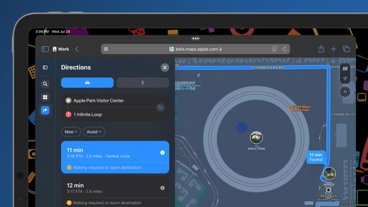Apple's AirPort grabs 10.6% share of 802.11n WiFi market
Stephen Baker, an analyst for market research firm NPD Group, told AppleInsider that Apple took 10.6% of the market in unit volume last month. He added that the company's revenue and profit share on sales of the routers are even higher.
Last year, Apple noted on its website that the AirPort Extreme was ranked by NPD as the top selling 802.11n router. While Apple no longer advertises that, Baker said that the AirPort Extreme has been the top selling 802.11n router for five of the last nine months.
Last week, the analyst told Macworld that the AirPort Extreme lead US retail sales as the top selling router in April, while the new Time Capsule topped sales as the most popular Network Attached Storage device. Despite their overlapping functionality, it was reported that strong sales of Time Capsule were augmenting sales of the AirPort Extreme base station rather than cannibalizing them.
Combined with sales of the compact AirPort Express, which was upgraded to support the faster 802.11n standard in March, Apple took fourth place in overall 802.11n base station sales, behind Cisco's Linksys brand, D-Link, and Netgear.
Apple markets its AirPort base station line to users of both Macs and Windows, which allows it to sell the product beyond its own user base, following the same cross platform strategy of the iPod, iTunes, QuickTime, and the iPhone. Linksys, D-Link, and Netgear also advertise Mac compatibility, but their products do not always deliver flawless support for Safari on the Mac. That helps give Apple a home field advantage in selling to Mac users.
Additionally, Apple's retail and online stores are selling AirPort base stations to new Mac users without any competition. "This stuff is just flying off the shelf in the Apple stores," Baker told Macworld. "They don’t get nearly enough credit for the value proposition that the stores bring."
On the Windows PC side, Apple still faces formidable competition. Baker told AppleInsider that Linksys "has recently delivered a number of new SKUs in the 802.11n segment that have done very well driving their volume." Several years ago, Linksys began using Linux-based software in its wireless routers, a move that compelled it to publicly release its source code under the GPL. That availability enabled Linux users to add previously restricted, high end router software features to low cost Linksys base stations, as well allowing Linksys' competitors to use its router software to compete against it with their own hardware. Linksys has since moved to using the proprietary VxWorks kernel in its flagship router products.
Apple's AirPort line also uses proprietary software, in addition to custom Mac and Windows client software for configuration rather than using a webpage interface as most base stations do. That may limit the appeal of its AirPort line among some Windows users, but it also allows Apple to install support for unique features that differentiate the AirPort line, including Bonjour automatic printer sharing and AirPort shared disk discovery as well as AirTunes audio streaming support from iTunes to an AirPort Express or Apple TV.
Brisk base station sales suggest that Apple's "fourth leg" behind its Mac, iPod and iTunes business, and the iPhone is not the emerging Apple TV but rather AirPort, a business segment that has performed well, albeit almost invisibly, since its introduction back in 1999, two years before the iPod.
 Prince McLean
Prince McLean













 Amber Neely
Amber Neely
 Thomas Sibilly
Thomas Sibilly
 AppleInsider Staff
AppleInsider Staff
 William Gallagher
William Gallagher
 Malcolm Owen
Malcolm Owen
 Christine McKee
Christine McKee









44 Comments
I must say my AE has proved to be very reliable. Now also running TM wirelessly and a USB printer for a network of 7 computers including a PC.
I think the high value is more about previous Intel Mac buyers with 802.11n hardware upgrading their networks rather than it particularly penetrating into Windows networks.
For instance, I have both an 802.11n capable Mac Pro and MacBook Pro that were bought some time ago and I have since upgraded two Airport base stations (Extreme and Express) to the new 11n models to complement my Gigabit network. Having to use 11g against a high-speed wired network is painful and 11n is not so much. Plus, selling, or reusing, the older Airport 11g hardware is easy given the huge installed base of 11g capable hardware.
The fourth leg would be stronger if they merged AppleTV+Airport+TimeCapsule into a single product.
The AppleTV already has WiFi and a hard disk.
The fourth leg would be stronger if they merged AppleTV+Airport+TimeCapsule into a single product.
The AppleTV already has WiFi and a hard disk.
While that's true, the AppleTV does already have wireless functionality you have to remember that it would not function well with NAS/Time Machine included. Its small 40GB drive already has to deal with audio and video and many people's libraries surpasses that. Additionally, the AppleTV uses 2.5" drives so potential storage is still limited compared to the 3.5" drives used in Time Capsule.
However, I do agree with you that base station functionality probably should have been added to it. If that were the case I probably would have gone with an AppleTV rather than an Airport Express unit as I need to extend my range from the position it would have been in.
While that's true, the AppleTV does already have wireless functionality you have to remember that it would not function well with NAS/Time Machine included. Its small 40GB drive already has to deal with audio and video and many people's libraries surpasses that. Additionally, the AppleTV uses 2.5" drives so potential storage is still limited compared to the 3.5" drives used in Time Capsule.
However, I do agree with you that base station functionality probably should have been added to it. If that were the case I probably would have gone with an AppleTV rather than an Airport Express unit as I need to extend my range from the position it would have been in.
Not to mention that location could be a problem for many users... Apple TV needs to be in the living room next to your TV and that's not the ideal place to keep your router.. Particularly if you have a printer attached via USB for the network.